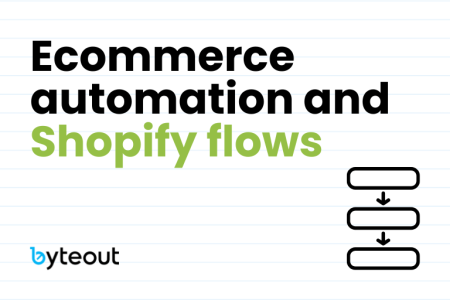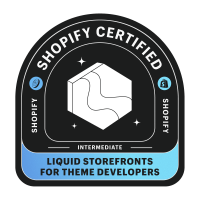
Ecommerce automation and Shopify Flows
Between managing inventory, tracking orders, and keeping customers happy, in ecommerce, the to-do list can feel ENDLESS.
But what if you could cut down on repetitive tasks and focus on growing your business?
Shopify Flow is a powerful automation tool that simplifies ecommerce operations and gives back precious time. You create Shopify flows based on your business needs.
Table of Contents
Why use automation in ecommerce
Automation uses tools and technology to handle repetitive and complex tasks so the business runs more efficiently. It helps save time and reduce mistakes. The goal is to free up time to focus on the bigger picture.
Use automation to deal with things like:
- Repetitive tasks like order processing, inventory updates, and customer follow-ups.
- Mistakes that occur during order processing, shipping, or product information updates.
- Marketing strategies like sending personalized emails, special offers, etc.
- Gathering valuable information.
What is Shopify Flow?
Shopify Flow is an automation tool that helps ecommerce businesses make their operations more efficient by automating repetitive tasks and processes. It’s designed to improve efficiency, save time, and reduce human error, allowing companies to focus on growth and customer experience.
The Shopify Flow itself makes it easy to create unique workflows without needing to code, so it’s a good option for everyone. It is available on Basic, Shopify, Advanced, and Plus plans.
The Shopify Flow app is found in the Shopify App store. After it’s installed, the app is accessed from the Shopify admin panel.
How to start using Shopify Flow
You can create workflows manually or use pre-made templates. Workflows start with a trigger, followed by conditions and actions. When building workflows, it’s important to consider potential delays, separate handling of orders and draft orders, tag limits, and asynchronous data fields that may cause unexpected results.
To create a workflow, use the freeform canvas in Shopify Flow: select a trigger, add conditions, define actions, and optionally include alternative steps for unmet conditions.
Templates offer a quicker setup for common scenarios.
And don’t forget – always test workflows before activating them to ensure they meet your expectations. The Shopify Flow is as good as you set it up.
3 template ideas for Shopify Flow
You can find pre-made templates or make one yourself. Here are some template ideas.
Track and reward top customers
This template helps you identify and engage your most loyal customers by tagging them based on their purchase behavior. Once tagged, you can reward them with perks like discounts, exclusive access to new products, or special loyalty program benefits.
How it works:
- The workflow starts whenever a customer makes a purchase or when their order is fulfilled.
- It checks if the customer’s total purchase count or total spend exceeds a defined threshold (e.g., 5 orders or $500 spent).
- Action: If the condition is met, the customer is tagged as “VIP” or “Loyal Customer.”
- Optional: Send an automated email offering a discount code or inviting them to a special event.
Some of the most-used Shopify flows are similar to this one – the workflow ensures your best customers feel appreciated, encouraging repeat purchases and long-term loyalty.
Manage inventory re-stocks
Ensure smooth inventory management and re-engage customers by setting up automatic notifications for low stock levels or restocked items. This template keeps your team and customers informed while preventing lost sales opportunities.
How it works:
- The workflow activates when a product’s inventory falls below a set threshold (e.g., less than 10 units).
- Action: Notify your inventory or purchasing team via email or Slack, prompting them to restock the item.
- Optional: If the product is restocked, automatically send “back-in-stock” emails to customers who previously showed interest or signed up for notifications.
By automating these steps, you minimize stockouts and maximize sales while improving the customer experience.
Pre-order campaigns
This workflow helps you manage pre-orders efficiently, keeping customers engaged and informed throughout the process. It’s perfect for new product launches or limited-edition releases.
How it works:
- Activates when a customer places a pre-order for a specific product.
- Actions:
- Automatically tag these customers with a label like “Pre-Order Buyer.”
- Add them to a specific marketing list to target them with pre-order updates.
- Send a personalized email confirming their order and setting expectations for delivery.
- Optional: Use follow-up emails to share sneak peeks, behind-the-scenes content, or updates about the product’s progress, building excitement and maintaining trust.
This workflow streamlines pre-order management and keeps your customers engaged, boosting satisfaction and retention.
Need some help?
Shopify Flow can be a really powerful tool, but it works best when set up strategically. If you’re tired of doing everything on your own, we’re there to help you set up the best strategy for you and everything related to Shopify – we love it, use it, and want to help Shopify merchants do their best in this crazy ecommerce world.
- Best ecommerce agency in US – Top 10
- Ecommerce automation – work smarter
- The % split – paid ads vs SEO vs organic social in ecommerce
- How to reduce Customer Acquisition Cost (CAC)
- Ecommerce automation and Shopify Flows
Let’s sum this up
With Shopify flows, ecommerce brands can create custom workflows using triggers, conditions, and actions or quickly set up processes with pre-made templates.
The tool is accessible without coding and available on Basic, Shopify, Advanced, and Plus plans. Key examples of workflows include tagging loyal customers to reward them, notifying teams or customers about low or restocked inventory, and managing pre-orders efficiently.
Let’s make ecommerce easy and successful!

